Warning signs for non-potable waters are designed to alert users and the general public about the hazards of non-potable water or situations affecting health and safety.
The intention is to reduce the risk of exposure including serious accidents.
Non-potable (recycled) water sources include:
- greywater
- treated wastewater
- industrial wastewater
- sewage (yellow water and black water).
Sites using non-potable water are required to display signage indicating its use.
Warning signs will need to comply with the following Australian Standards (AS):
- AS 1319 – 1994 Safety signs for the occupational environment
- AS 2416 – 2002 Design and application of water safety signs
- AS 1744 – 1975 Forms of letters and numerals for road signs
- AS 2700S – 1996 (R13) Colour standards for general purposes – red
- ISO 20712 – 1:2008 Water safety signs and beach safety flags – Part 1: Specifications for water safety signs used in workplaces and public areas.
Warning signs for non-potable waters may incorporate symbols, text or a combination of both.
The use of symbols is preferred as they are easily understood for people who may be exposed to non-potable water including:
- children
- people whose primary language is not English.
Symbols shall include the recommended international public information symbol for drinking water with the regulatory prohibition overlay in red.
Prohibition messages have a red circle and a slash symbol with a plain white interior (see example below).
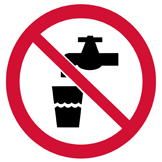
Word messages shall be complete within themselves regardless of whether a symbol is also used on the sign.
Signs shall have a white background with word legend in black in all cases.
Words shall be Non-potable Water – Do not Drink / Avoid Contact (see examples below).
A black border with white surround may be placed around the sign board.
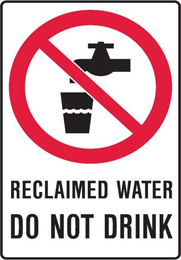

Danger signs have words only and messages that can only be classified as warnings of hazards and it is recommended when sewage is used.
Signs in this category are of a special design which incorporates the word DANGER in white letters on a red symbolic oval shape.
The signs shall comprise a white rectangle with black enclosure and white surround with the DANGER symbol on a black background placed above or to the left of the white rectangle (see example below).
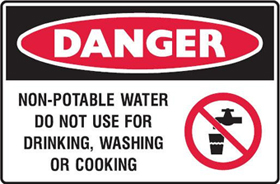
Emergency information signs shall comprise a white symbol or worded legend, or both, on a green rectangular sign with white enclosure (see examples below).
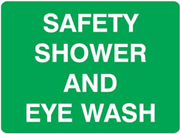
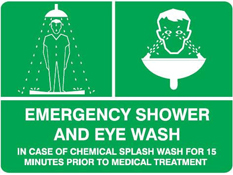
Rules for sign usage
Do:
- paint signs directly on existing surfaces
- remove signs if the information they contain or the location is no longer relevant
- place signs as close as possible to the observer’s view
- ensure sign messages are legible and clearly visible to all people
- keep signs clean and in good condition
- mark and label all pipes and use signs to indicate non-potable water reuse
- check signs regularly and replace those that are deteriorated by the environment conditions
- include explanation of signs the functions and meanings in the employee induction training programmes
- sign materials should be selected taking into consideration its location.
Don’t:
- construct or erect signs in a way that they can harm people
- have too many signs in the same area
- place signs that can be obscured by physical obstruction.
Signs do not replace the need to implement risk prevention and other risk management measures.
Mandatory signs requirements for areas irrigated with non-potable (recycled) water
- Areas to be irrigated should be clearly designated with signs to indicate that contact must be avoided.
- All wastewater ponds, dams and tanks should be clearly sign posted.
- Mandatory signs (WHITE background with BLACK lettering) in broad irrigation areas must be a minimum of 20cm x 30cm in size with letterings of at least 20mm in height.
- Install signs around irrigation systems where non potable water is used to alert people that it is not drinking water (see example below). Safety signs must be fixed at all non-potable outlets.
- Signs should be worded as follows:
- RECYCLED WASTEWATER – DO NOT DRINK / AVOID CONTACT.
- Variations also acceptable:
- THIS OVAL IS IRRIGATED WITH RECYCLED WASTEWATER – DO NOT DRINK
- NON-POTABLE WATER IN USE – AVOID CONTACT – DO NOT DRINK
- RECYCLED WASTEWATER IRRIGATION – AVOID CONTACT – DO NOT DRINK
- NOTICE – GREYWATER USED ON GARDENS & LAWNS – AVOID CONTACT.
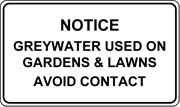
Warning signs requirements for residential dual reticulation and in-house uses of non-potable water
- Non-potable outlets (connection and taps) must be clearly marked with warning signs WARNING DO NOT DRINK or WATER NOT SUITABLE FOR DRINKING or similar in accordance with AS1319.
- Warning signs (yellow background with black lettering) must be permanently affixed above all taps for high exposure risk level recycled schemes as per Guidelines for the use of recycled water in WA.
- All safety signs must be attached securely above the outlet.
- Toilet cisterns require a warning sign, as an extra precaution.
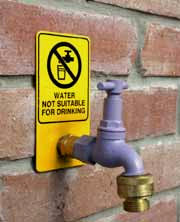
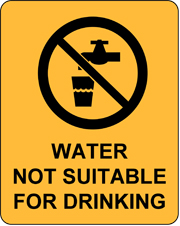
Plumbing colour code
All below ground pipes (including those used for sub-surface irrigation) shall have an identification tape.
Those are to be marked in accordance with the Australian/New Zealand Standard AS/NZS 3500.1.
All fixtures and piping carrying non-potable water shall be purple in colour in accordance with Australian Standard AS 2700.
All fixtures are required to have warning signs attached.
More information
- Water Unit, Environmental Health Directorate
Telephone: 9222 2000
Email: ehinfo@health.wa.gov.au
Fax: 9222 2000
Postal address: Department of Health, PO Box 8172 Perth Business Centre WA 6849